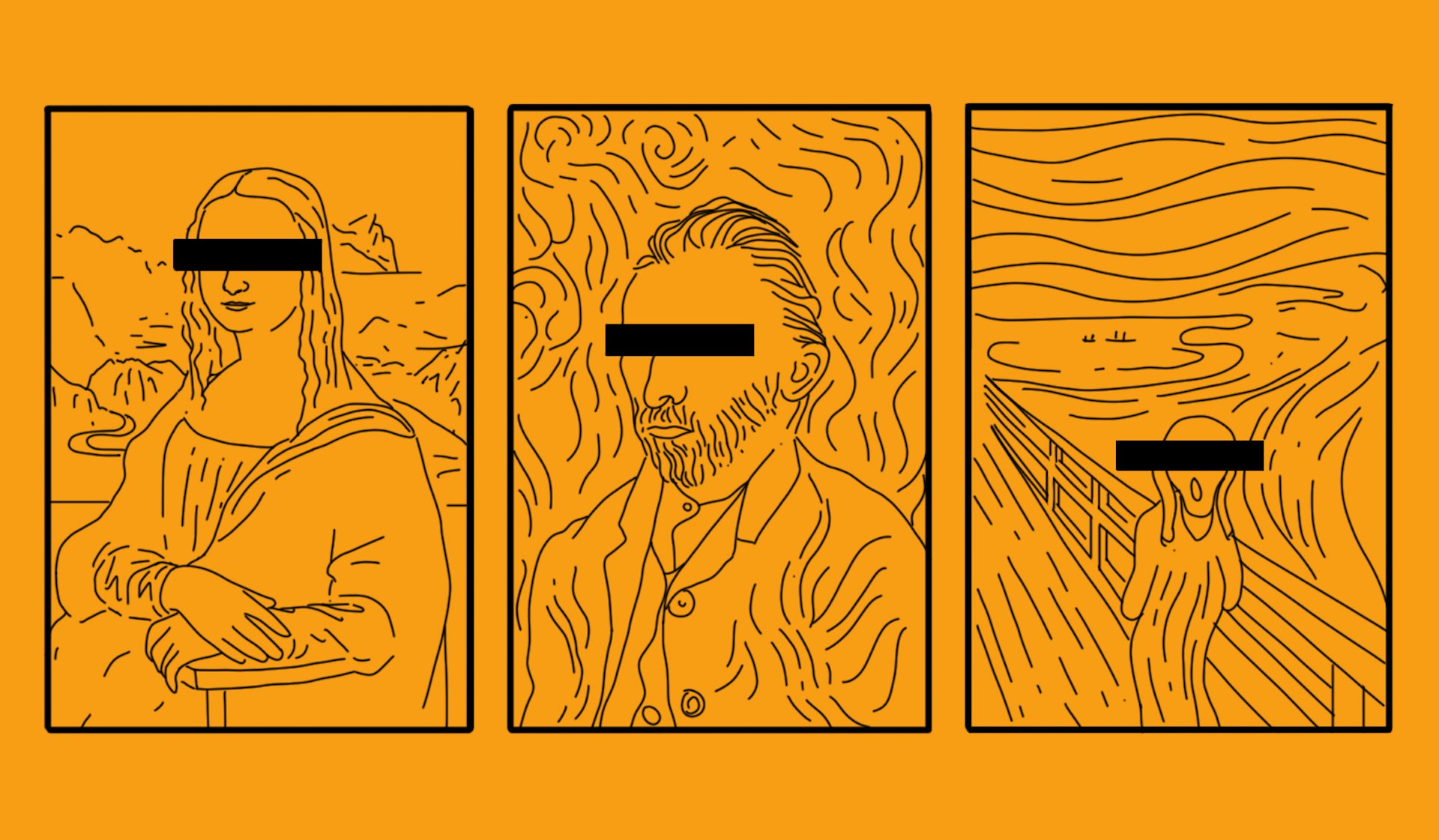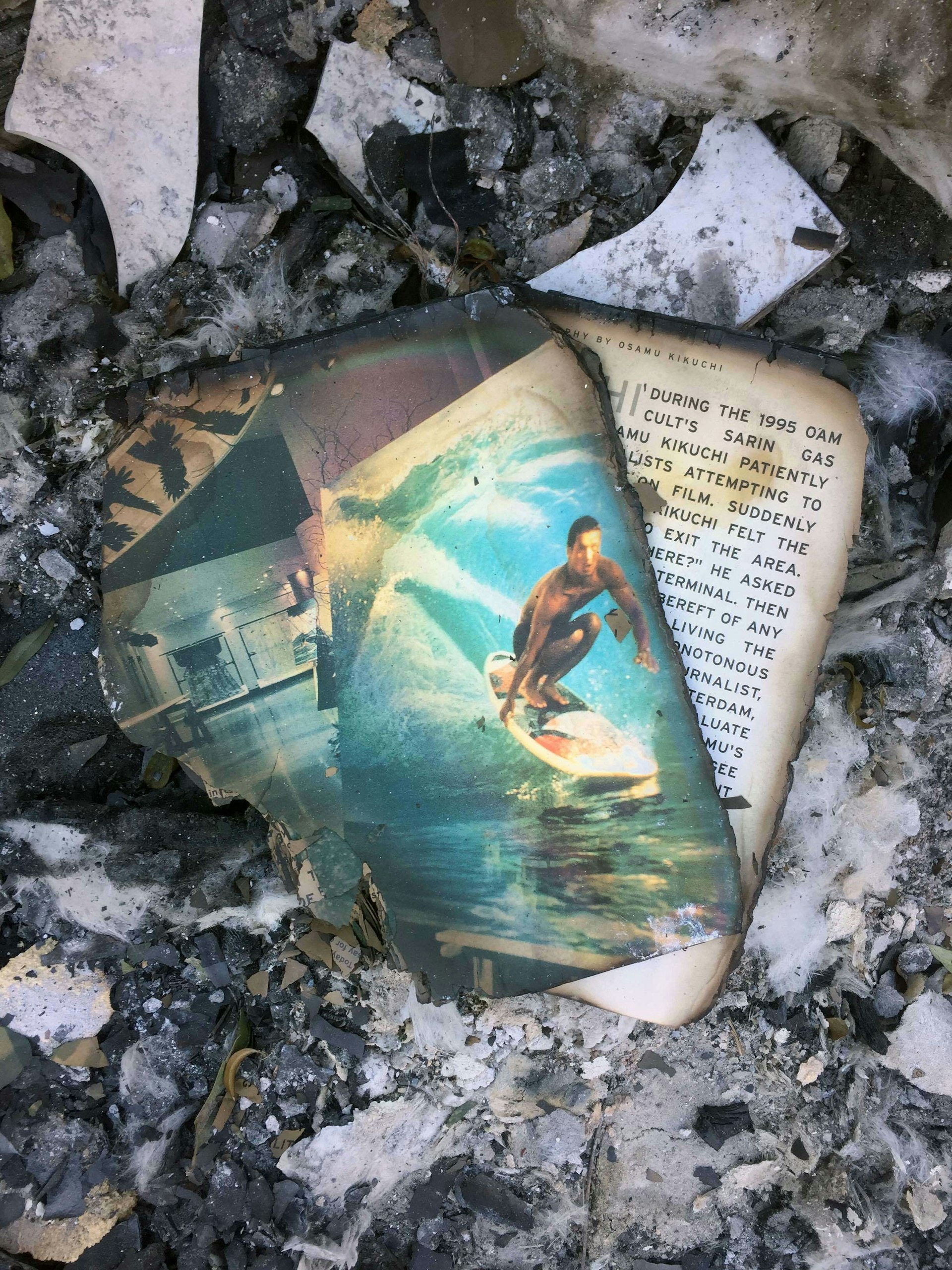
California fires: what it’s like to lose your home to flames
- Text by Jamie Brisick
- Photography by Jamie Brisick
It’s been two months since I lost my home in the Woolsey Fire, and while I have been waiting for it to hit hard, to experience some kind of PTSD, that feeling has yet to come. Perhaps my life in surfing has taught me to be non-materialistic. Perhaps all those Pema Chodron audiobooks (When Things Fall Apart; Fail, Fail Again, Fail Better; Living Beautifully with Uncertainty and Change, etc.) have actually sunk in. Perhaps I’ve just got really good at bullshitting myself.
I received the text message just before 7am: Mandatory evacuation for the entire city of Malibu. I grabbed my laptop, my writing stuff, and a change of clothes, then got in my car and headed south on Pacific Coast Highway, only to find a clusterfuck of fellow evacuators. Malibu is home to nearly 13,000 people, and about half of them were on that road. A billowing, apocalyptically monstrous cloud crept down the Santa Monica Mountains. Next to me, in the not-moving traffic, a bald man in a red convertible Porsche shouted into his cell phone. I wanted to roll down my window and say, “Totally ridiculous.”
“What?” he’d say.
“Your car in the face of this giant fire. It’s totally ridiculous.”
But I did not. Instead, I flipped a U-turn, drove back to my sweet little Point Dume guesthouse, grabbed my camera, and beelined to my local surf spot, Zuma Beach. Zuma has a long, paved parking lot that abuts the sand, and I’m pretty sure that the several-hundred residents gathered there had the same idea as I did: that water can’t burn, that by hugging the shoreline we were safe. Many of them were with their animals – a llama tied to a lifeguard tower, a young girl walking a trio of horses across the sand. Some wore oxygen masks. One dude wore a gas mask straight out of World War II.
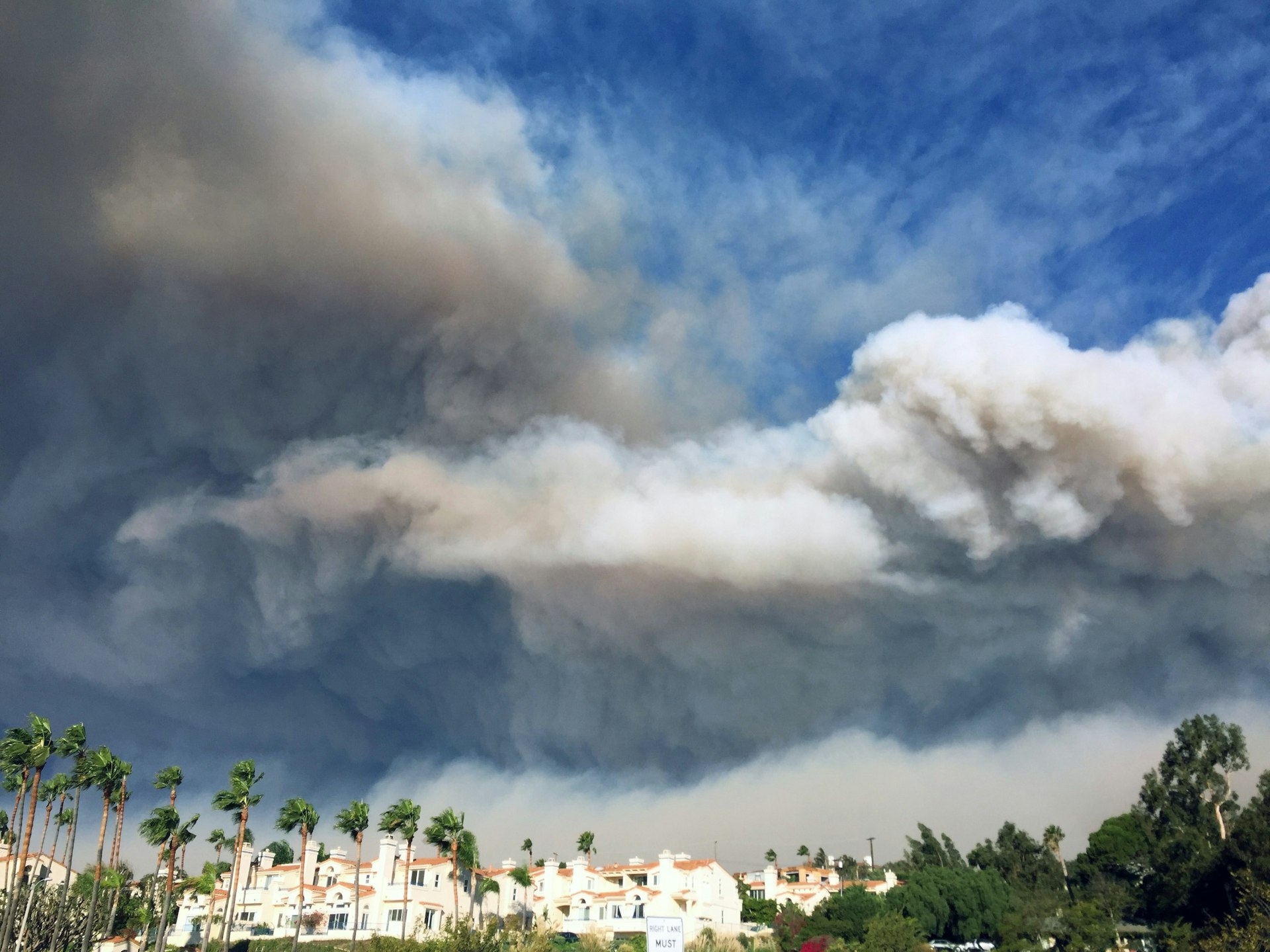
The Woolsey Fire, during my first attempt to evacuate at around 7:30am. As seen from PCH, just west of Paradise Cove.
I parked and wandered through the crowd, taking pictures and talking to my Malibu neighbours. I saw a friend who lived in a canyon off Mulholland Drive. “Our home is gone,” she told me. I saw a woman of great cosmetic augmentation huddling close to a silver Hummer and had the same reaction I’d had on PCH an hour earlier. To the west, the Trancas Canyon hillside was aflame. Not in a single wall of fire, but in scattered pieces. The smoke that roiled seaward looked like something out of a cartoon. Across PCH, not too far up the hill, a flurry of black smoke swirled skyward. It was not of the brush fire sort; it was blacker, more industrial. A few seconds later I saw flames so close I could have almost thrown a tennis ball and hit them.
Now might be a good time to get out of here, I thought, not because I’d become engulfed in flames, but because of the massive traffic jam I anticipated. I drove out of the parking lot, along Westward Beach Road, up Birdview, and up Bluewater. Across the street from the sprawling property owned by Bob Dylan, a woman waved me down.
“My gate is broken,” she said. “Can you help me?”
It turns out that the power company had killed the power in all of Point Dume. The woman – sixtyish, kindly, anxious – had packed her dog and valuables in her SUV, but she could not exit her driveway. With a lot of elbow grease I managed to slide the electric gate open. She pulled onto the street, stepped out of her car, and thanked me.
“We might want to close the gate behind you,” I said. “This is pretty much a looters’ paradise.”
“I was going to leave it open,” she said, and showed me the cardboard sign that she’d prepared: Thank you fire fighters. Pool in backyard. Help yourself.
With duct tape we hung it from her mailbox. She looked me up and down.
“You’re not a looter, are you?”
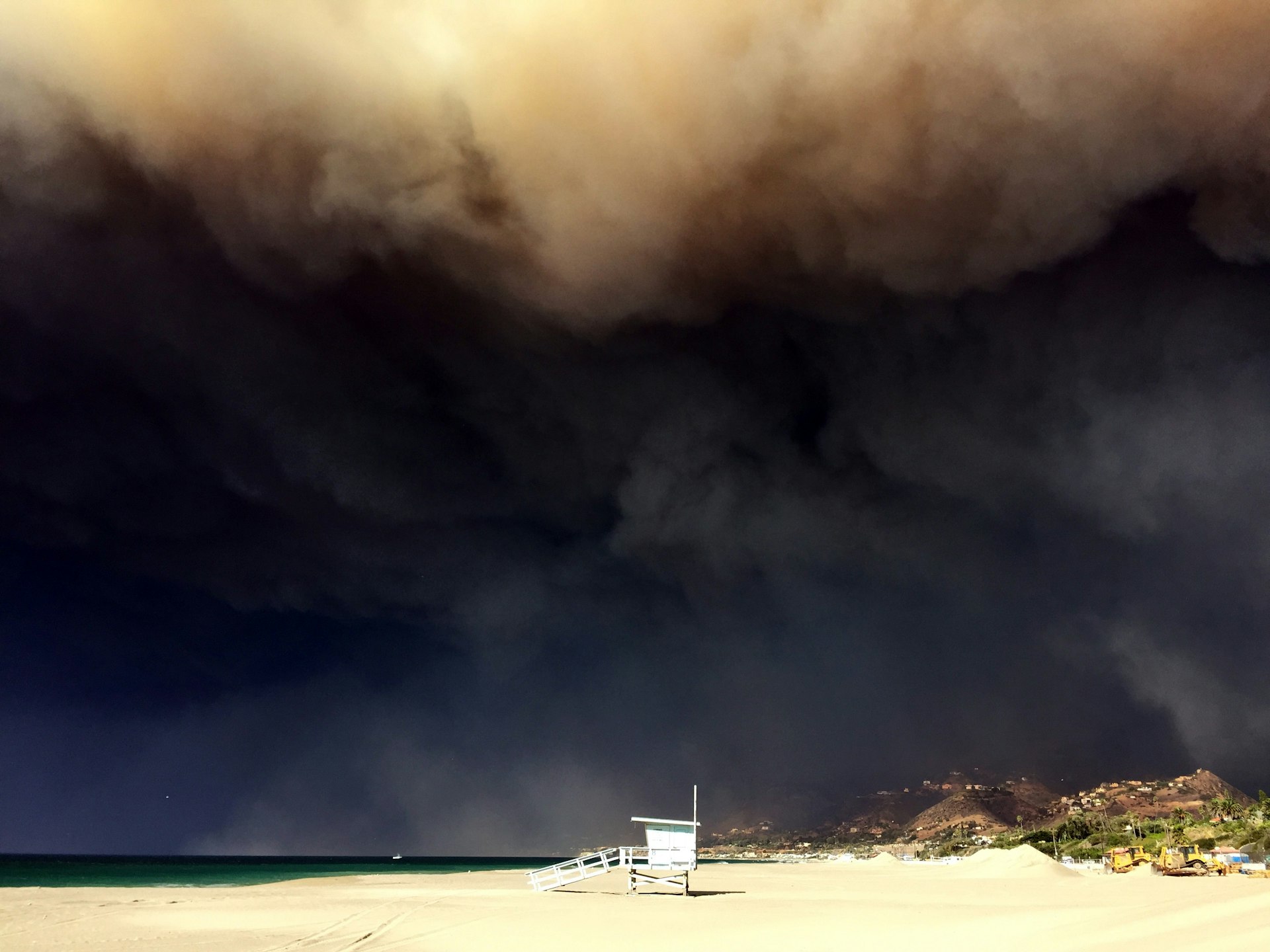
My beloved Zuma Beach. I started surfing here in the late ’70s. Not a great wave, but a spawning ground, and a home break.
I drove out of Point Dume and turned south on PCH. At Portishead I saw a group of guys standing alongside the road, taking in the fire. I pulled over and joined them. One was drinking a can of something. It wasn’t a beer, but I wanted it to be. We slipped into talk about surfing, how long we’d lived in Malibu, the Chumash Indians who’d lived here long before we white folk did, JoJo Perrin’s cutback – everything but the fire.
Smoke blanketed the sky. It billowed and folded and wrinkled like some giant, shape-shifting brain. For a few seconds it swirled into a hellacious asshole.
“That’s bad news,” said Dave, a sun-ravaged surfer in his late sixties.
He pointed towards a streak of flames just south of Kanan Dume Road, the artery that connects the valley to the beach. It was headed in our direction.
One of the guys reached into the trunk of his car, a black Dodge Challenger with a vanity plate that read ‘JAHSATN’. He pulled out a six-pack of Cokes and offered them around.
I passed, wished them good luck, got in my car, and continued south, thinking I’d go visit my mother in west LA and stay the night at her place. But traffic was still ridiculous. Just north of Pepperdine University I got off at a secret exit, parked, scampered up the side of a scrubby hill, and took more pictures. Point Dume is a Los Angeles icon. You’ve seen it in the background of movies, TV shows, and commercials. It curves sexily out to sea. By this time, about 1pm or so, it had become completely dwarfed by the black-brown-grey smoke cloud that reached up into the solar system. Somehow this made me thirsty, and I thought I’d go to Ollo, a restaurant in the Malibu Colony Plaza frequented by semi-recognisable ageing actors in tennis garb, and sit at the bar and drink a glass of wine and try to process all that I’d taken in that day. But Ollo was closed, and so was every other establishment in the plaza.
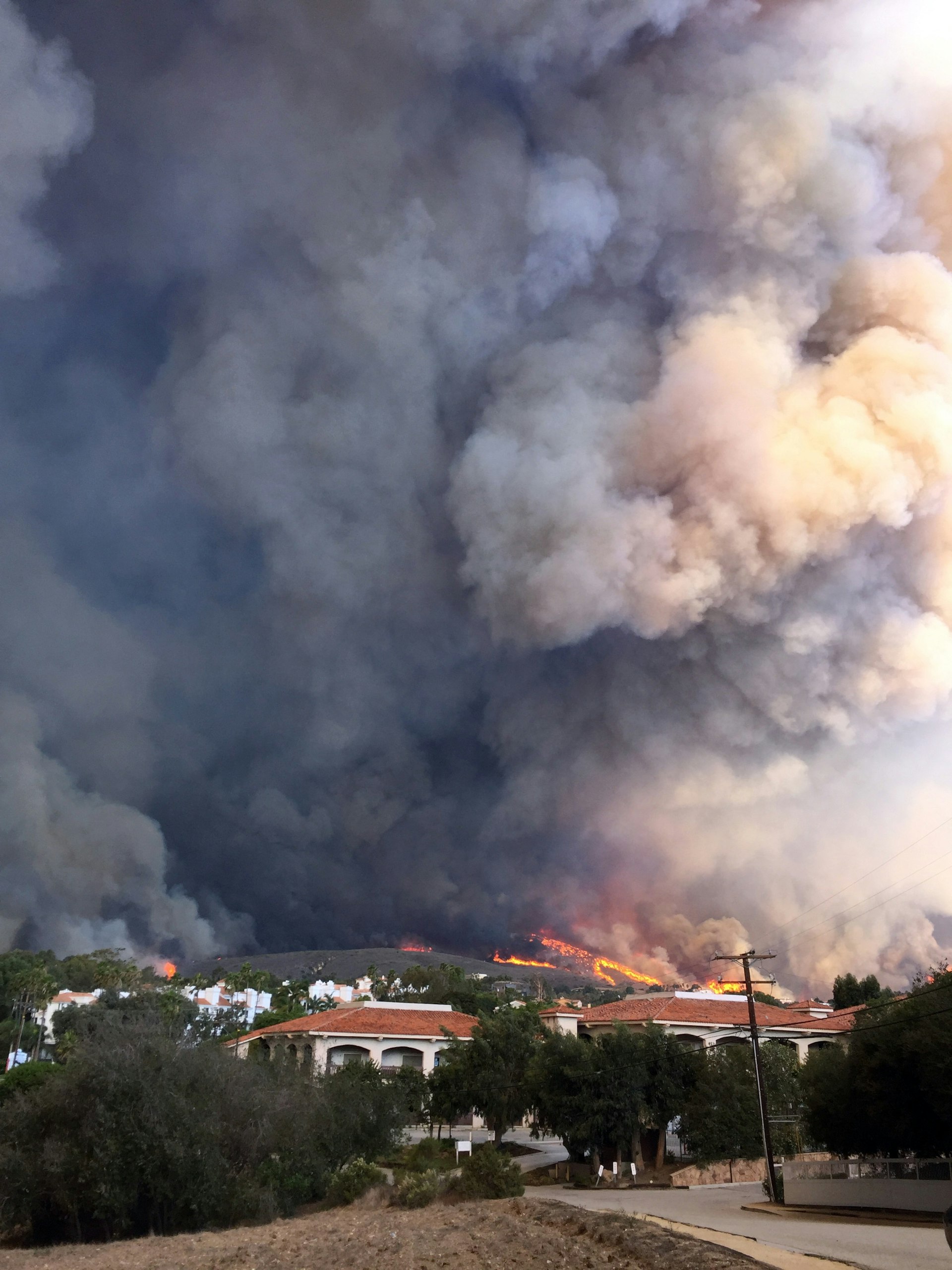
From Portishead Road, looking across PCH towards Kanan Dume Road.
I got back on PCH and inched my way south in the hideous traffic. It took nearly four hours to get to Santa Monica (normally it’s 30 minutes). By that time I’d forgotten all about the fire – I was focused solely on The Talpa, a family-owned Mexican restaurant on Pico Boulevard. I parked in the back alley, entered through the back door, and took a seat alongside my happy-hour friends at the bar, where news coverage of the fire played on an overhead TV. I ate beef tacos, drank skinny margaritas, and watched the region of LA that had figured largely in my teens and twenties burn down. I felt anxious and sugary and drunk. Eventually I stumbled out to my car and crashed in the back alongside my five-ten twin-fin and clammy wetsuit.
The following day I hung out with a friend who lives in Venice. The air was thick and ashy. The smoke cloud that hung over Malibu was like some wrath-of-God monster. In the evening we turned on the news and the first thing we saw was my guesthouse. A firefighter blasted water at my burning bedroom. Flames devoured the very spot where I slept, dreamt, fornicated. It was a strange feeling – made even stranger when they played that image repeatedly throughout the weekend. I became a poster child for the Woolsey Fire.
The next few days accentuated my conflicted relationship with Malibu life. Many of my fellow evacuees took rooms in five-star hotels in Venice and Santa Monica. I received invitations to festive dinners and languorous brunches. Wild rumours were cooked up over $6 coffees. A designer fashion label was offering free clothes to people who’d lost their homes, and everyone flocked there. It felt too easy.
Meanwhile, I could not get back into Malibu. Roads were closed on the north, south, and valley sides. On social media I read posts from friends who stayed. “Never felt a stronger sense of purpose.” “We can’t wait for an institution to take care of us, we have to do it ourselves.” On the news, I watched interviews with my surfer friends. They’d banded together and formed the Point Dume Bomberos. They were saving houses – and possibly lives. There was this whole Lord of the Flies micro-community happening, and I was missing out on it, and that hurt.

A couple of skinny margaritas into my dinner at The Talpa, I saw this on the news. Kanan Dume and PCH—about a quarter-mile from my home.
I got in the following day, thanks to a filmmaker friend who made me a press pass. Driving west past Surfrider Beach, the Pacific Coast Highway eerily quiet, I watched a set of gorgeous waves peel across First Point. There was no one on them. Malibu is one of the most crowded breaks on earth. The road closure would create empty lineups akin to the pre-Gidget days. I reached back and pawed the nose of my five-ten twin-fin.
I passed places of great personal significance: the surf spot where I got my first tube; the former home of The Malibu Inn where I consumed a half-decade’s worth of soggy oatmeal and burnt coffee hoping to get closer to a particular waitress; the rocky outcropping where my late wife and I shared one of our last meals together, a picnic of cheese and avocado sandwiches, the shore break slapping and hissing below our feet. I started surfing in the late 70s. Malibu was my playground. It’s as close to my heart as any geographical place I can think of. But to be a surfer is to be a traveller. In my early twenties I started travelling, and pretty much kept travelling.
The first sightings of the fire were just north of Pepperdine University. The charred hills took on a certain vulnerability, vegetation gone, trees skeletal, bald black curves shimmering in the midday sun. Born and raised in LA, now 52, I have come to understand that it’s essentially a race between the Santa Ana winds and the rain. If the rain comes first, the fire hazard is mitigated. But if the fires come first, as they had now (and as they did last year, with the Thomas Fire and the ensuing mudslides in Montecito), we’re in big trouble.
A fire truck flew past, behind it a GTE truck, and behind that a Caltrans vehicle. Downed telephone poles obstructed the number two lane. I’d been warned about hot power lines. To my right were charred black hills as far as the eye could see; to my left the blue Pacific shimmered almost smugly. I passed the former home of my friend Strider Wasilewski, a pro surfer, husband, and father of three young boys. The wooden A-frame, their dream home, had burned to the ground.
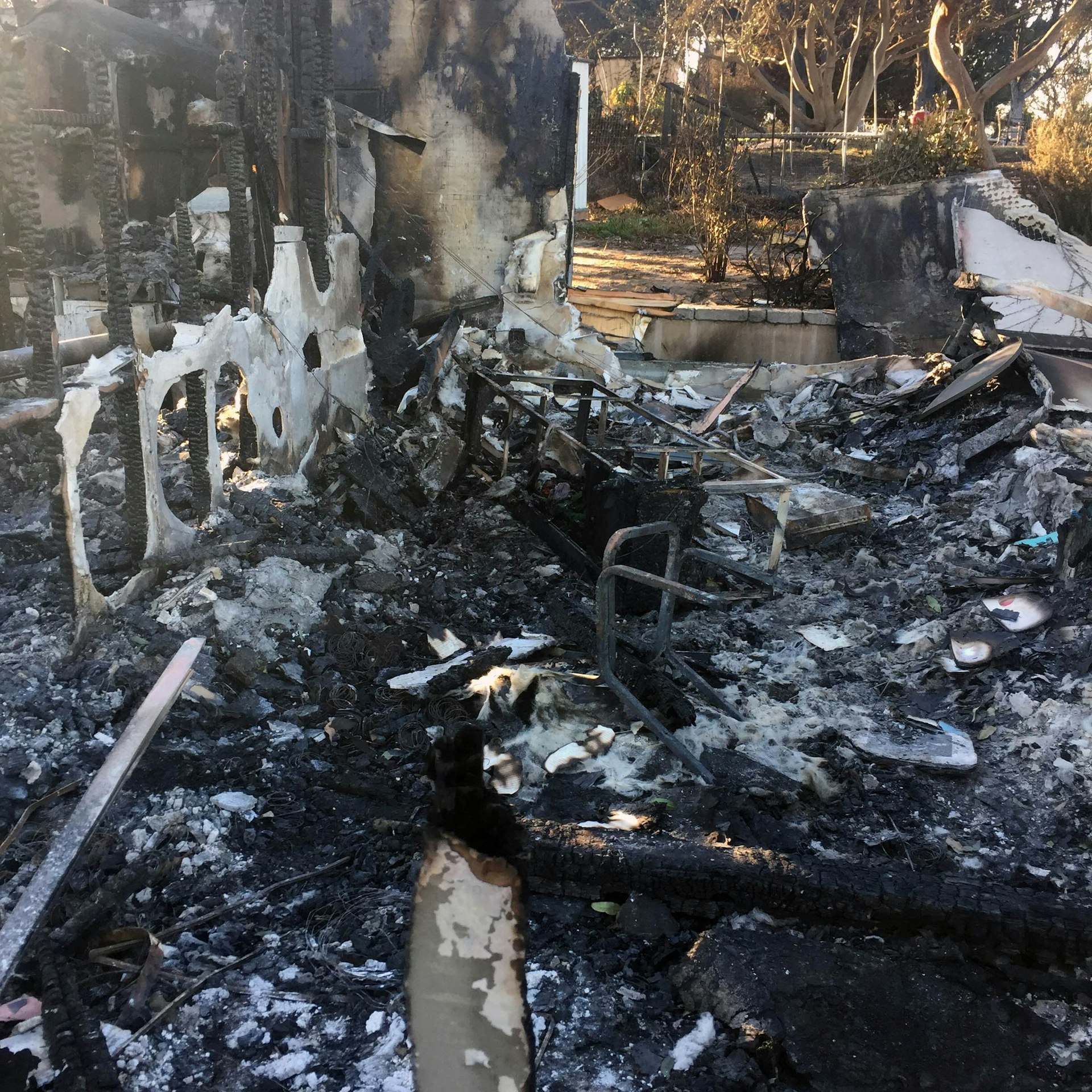
My former bedroom. On the right, my former desk. On the left, my former bookshelf and reading chair. In the foreground, my former bed.
I turned left on Heathercliff and left on Dume Drive, my street. Some homes were perfectly intact; others had been reduced to a physics-defying flatness. There was an odd randomness to it; you could almost see the embers flying over one and inflaming the next. The ugliest house on the block, a gaudy McMansion, still stood. I remembered Voltaire: “God is a comedian playing to an audience too afraid to laugh.”
The homes leading up to mine were gone, and so were the homes across the street. I pulled into the gravel driveway and got out of my car. The burning smell was like a punch in the face. There was nothing left of the front house, a ranch style home where my neighbours – a husband, wife, twin 13-year-old daughters, and two loud dogs – had lived. I followed the winding concrete footpath back to my guesthouse. It used to be shaded by trees, but the trees were no longer. Same with the surfboard rack that held a half-dozen prized boards. I’d never seen a burned surfboard before. The foam had disintegrated, but the fiberglass husks remained. They resembled shed skin, or cocoons.
My house was pretty much what I expected: burned to the ground, save for the collapsing front wall. Hot spots still smouldered. There were thousands of nails. I walked across the corner of the room where my bed used to be and fossicked through the mess of charred books that had spilled from what had been a built-in shelf. The pages were scorched in a way that smacked of the passing of time. They looked solid, but crumbled at the touch of my hand. I found some of my longhand writings on a legal pad. I unearthed a book and turned to a picture of my friend Takuji Masuda riding a blue wave, black char closing in on him from all four sides.
I did not feel some huge sense of loss. In fact, it felt strangely familiar. In 2013, my wife of nine years died suddenly, in a cycling accident. After 11 years in New York, I moved back to LA with little more than a backpack over my shoulder. For the first year, I crashed on my sister’s sofa in Culver City. When the opportunity to live in a cheap guesthouse arose, I jumped at it. Living in Point Dume was a luxury I never imagined. I wrote, surfed, and rode my bike in the hills above Zuma Beach. It felt almost too good. And perhaps knowing firsthand the way our lives as we know and love them can disappear overnight, it felt temporary.
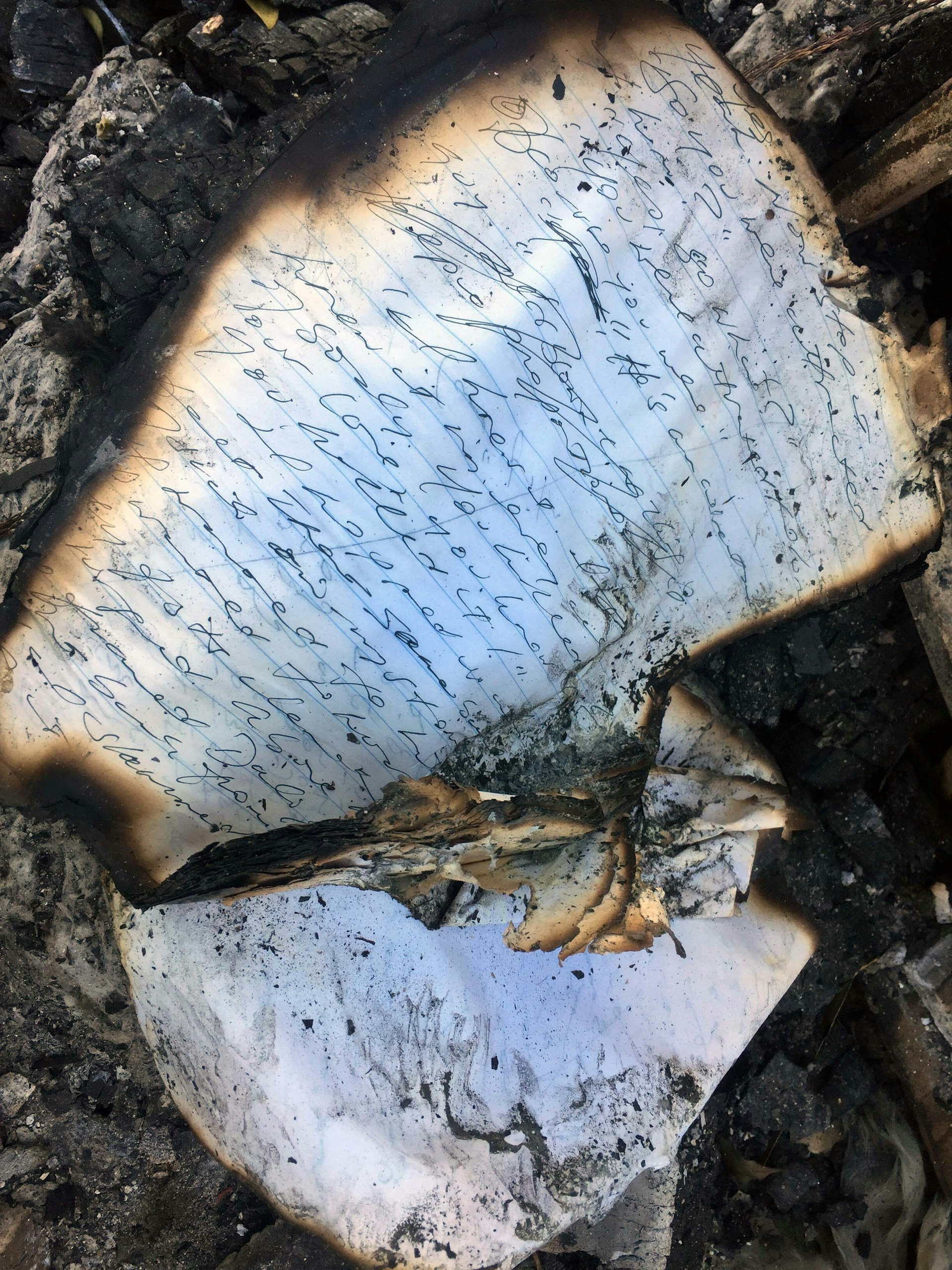
In the ashes I found surviving passages from my novel-in-progress. On this surviving page, the protagonist gets angry and shoves his fist through a framed print of Dali’s Corpus Hypercubus.
That evening, I gathered with other Malibu residents who had stayed around at the Point Dume Marine Science Elementary School. The parking lot had been turned into an emergency operations centre. Ash-covered firefighters lined up for food. Folks I’d seen around town but never spoken to scooped up salad, rice, curried chicken, vegetables, cake, and ice cream. There was a warm and friendly vibe. Hugs lasted a little longer. “How’d you do?” had become shorthand for “Did your home survive?”
I ran into a few of my surfer friends. “I show up and my house is gone, and there’s a spot fire in the house next door, and there’s a house – your house – burning,” my neighbour Keegan Gibbs told me. “Those immediate tasks, and that emotional connection with all these people.” He nodded towards our fellow parking-lot gatherers. “That’s what has allowed me to be okay with all this.”
Zuma Beach resident Charles Smith said: “It’s nice to be appreciated for being a big, dumb guy with shoulders that can swing an axe for a couple of days.” He went on to tell me how, in the several dozen burned-down homes he’d encountered, nearly every one had some surviving memento or totem. “One house would have a little Jesus statue, the next would have a smiling, laughing Buddha. It was almost fated: the one thing that people needed to see had escaped the flames.”
Most of everyone gathered in that parking lot looked physically beaten down by the around-the-clock firefighting. But their spirits were way up. The sense of community, the sense of coming together for the higher good (corny as that sounds), was palpable. Normally, the big shots of Malibu are the rich and famous, the ones who own the five-million-dollar homes. The fire had turned this hierarchy on its head. These guys – these surfers – were the new heroes. At least for the time being.
That night I crashed at a friend’s surviving home – no electricity, just candles and tequila. In the weeks leading up to the fire I’d been hearing lots of coyotes. There were none that night. The fire smell was all-encompassing.
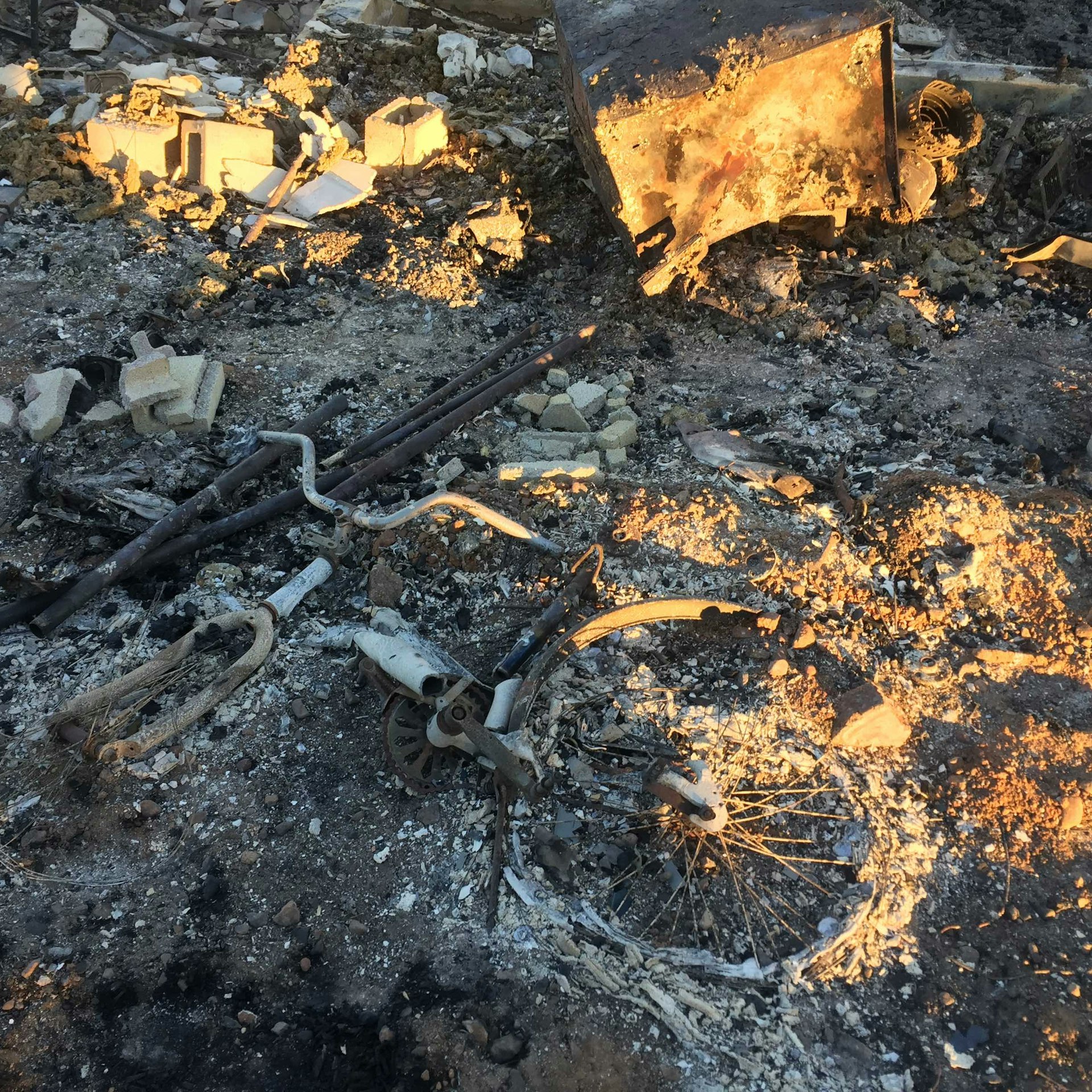
Walking through the Valley of Death had a kind of Pompeii effect. The fire had happened less than a week ago, but the things I encountered looked like they should have been ancient.
There was something else that now seems like a premonition, though I didn’t see it that way at the time. A couple of weeks before the fire, the Grateful Dead song ‘Touch of Grey’ took up residence in my head. “I will get by, I will get by, I will survive” played over and over like a mantra. That led to more Dead songs, and by the time of the fire I had that music bouncing through me, a kind of insulation.
The next morning I went for a walk through the ravine behind where my guesthouse used to be. Once thick and furry with vegetation, it was now black and exposed, a sort of Valley of Death. The surrounding homes were all vacant. The silence was eerie. I felt like I’d stepped into a Mad Max movie. I saw a charred kids’ bike that looked almost fossilised. I nearly stepped on a little glass crack pipe.
On my way back to Venice, I saw sparkling, shoulder-high waves at First Point with only three guys in the water. The parking lot was nearly empty. Stepping out of my car, I was immediately surrounded by a flock of hungry pigeons. They were used to feeding on human leftovers, but there were no humans on the beach. I paddled out, got many good ones, felt part Garden of Eden, part post-Apocalyptic.
Between waves, I turned to my friend Tim Hazelip, a First Point regular. “This is surreal,” I said.
Tim smiled knowingly. “Once in a decade, bro. Once in a decade.”
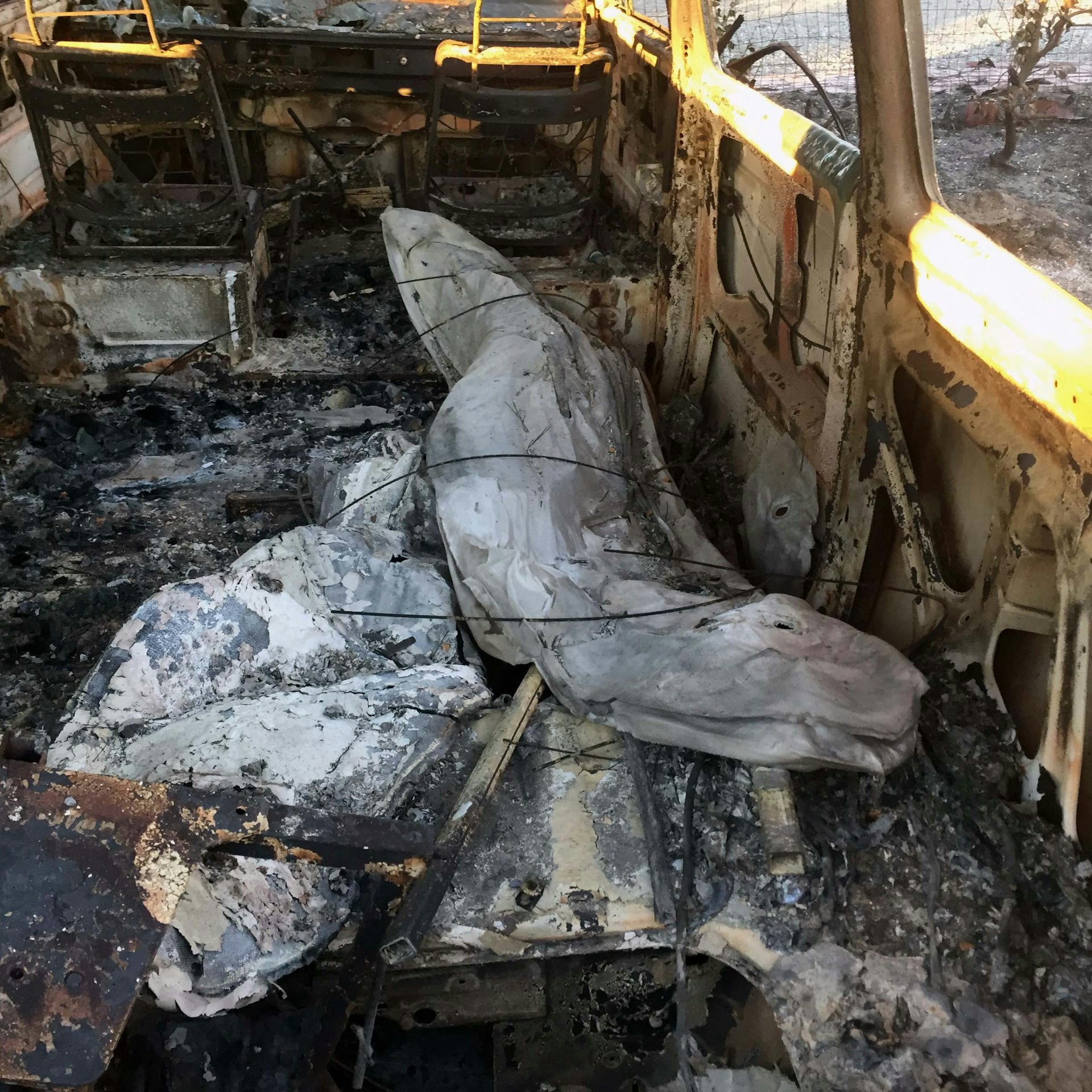
Vanagon with kayak.
A shorter version of this article also appeared in The New Yorker.
Jamie Brisick is a Contributing Editor at Huck. Follow him on Twitter.
Enjoyed this article? Like Huck on Facebook or follow us on Twitter.
